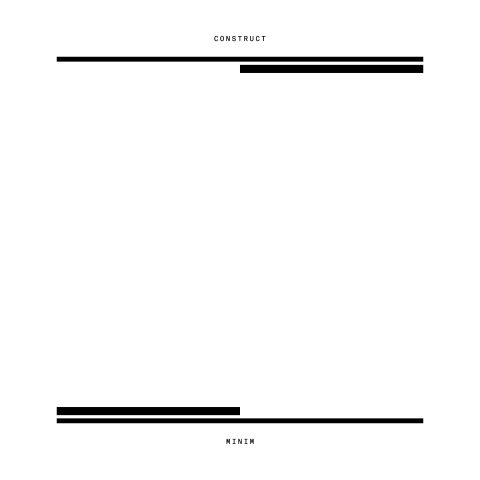Devo essere sincero, quando leggo che un disco è pubblicato in SD card metto mano alla pistola. Diciamo che, fuor d’ironia macabra, preferisco avere a che fare con formati un po’ più ingombranti e tattilmente godibili. Stavolta però mi sono dovuto ricredere, a malincuore ma è giusto ammetterlo.
minim, al secolo Diana Dulgheru, è una sound artist rumena che sperimenta con concetti estremamente formalisti, e per l’occasione agisce sul suono riflettendo sull’opposizione tra costrutto e oggetto inquadrato nell’ottica della filosofia della scienza: un oggetto ideale dipende dalla mente di un soggetto, non è direttamente percepibile ma la sua coscienza si basa su altri concetti che aiutano a spiegarlo. In base a questa visione estremamente speculativa, e a un tale monicker aggiungerei, la musica composta per Construct risulta estremamente minimalista (accompagnata ovviamente da un grazioso artwork ridotto a poche linee nere su sfondo bianco).
Siamo nei territori di un Ryōji Ikeda ancora più liofilizzato e ridotto alla basicità, un sapiente sviluppo di pochi suoni giustapposti omogeneizzati in fredde tracce ritmiche. Metodo già utilizzato egregiamente da gente come Toshimaru Nakamura, qui concepiti ancora con maggiore distanza scientifica.
Otto tracce che sviscerano la ritmicità in modo estremamente cerebrale, muovendosi tra tempi concilianti e improvvise sincopazioni, senza risultare però scostanti nonostante il discorso sia praticamente ridotto all’osso di un glitch strutturalista e gli arrangiamenti si basino su semplici posture di addizione e sottrazione. Il senso della composizione e del dettaglio rende in realtà l’ascolto piacevole, tanto da farti sprofondare in un loop percettivo e mentale che trascende e completa lo sviluppo espressivo dei pochissimi elementi.
Alla fine tutto torna, diventa afferrabile anche la scelta del formato, e la musica, oltre ad affascinare, si sostanzia come una parte di un progetto più grande reso in modo mimale partendo da basi complesse. Il merito è proprio di una freddezza così estrema che sorprendentemente stimola per eccesso tepore, sicuramente cerebrale, e graffia con la sua grana: è pur sempre interessante essere accompagnati da questa colonna sonora mentre si riflette sull’impalpabile metafora che unisce la costruzione di costrutti sonici e l’inafferrabilità dei materiali sonori di partenza. Questo vi spingerà, oltre che a godere della piacevolezza dell’ascolto, anche a mettere più di qualche volta il disco nel lettore card. La prossima volta, comunque, può andare benissimo un semplice compact disc.
— Massimo Onza via Sodapop
minim, born Diana Dulgheru, is a Romanian sound artist who experiments with extremely formalist concepts, and for the occasion acts on sound by reflecting on the opposition between construct and object framed from the perspective of the philosophy of science: an ideal object depends on the mind of a subject, it is not directly perceptible but his consciousness is based on other concepts that help explain it. Based on this extremely speculative vision, and such a monicker I would add, the music composed for Construct appears extremely minimalist (obviously accompanied by a lovely artwork reduced to a few black lines on a white background).
We are in the territories of an even more freeze-dried and basic Ryōji Ikeda, a skilful development of a few juxtaposed sounds homogenized into cold rhythmic tracks. Method already used very well by people like Toshimaru Nakamura, conceived here with even greater scientific distance.
Eight tracks that dissect the rhythm in an extremely cerebral way, moving between conciliatory tempos and sudden syncopations, without however being off-putting despite the fact that the discussion is practically reduced to the bare bones of a structuralist glitch and the arrangements are based on simple postures of addition and subtraction. The sense of composition and detail actually makes listening pleasant, so much so that you sink into a perceptive and mental loop that transcends and completes the expressive development of the very few elements.
In the end everything comes back, even the choice of format becomes understandable, and the music, in addition to fascinating, takes shape as a part of a larger project rendered in a mimic way starting from complex bases. The merit is precisely of such an extreme coldness that surprisingly stimulates excessive warmth, certainly cerebral, and scratches with its grain: it is still interesting to be accompanied by this soundtrack while reflecting on the impalpable metaphor that unites the construction of sonic constructs and the elusiveness of the source sonic materials. This will push you, not only to enjoy the pleasure of listening, but also to put the disc in the card reader more than a few times. Next time, however, a simple compact disc might be fine.
— Automatic Google translation
